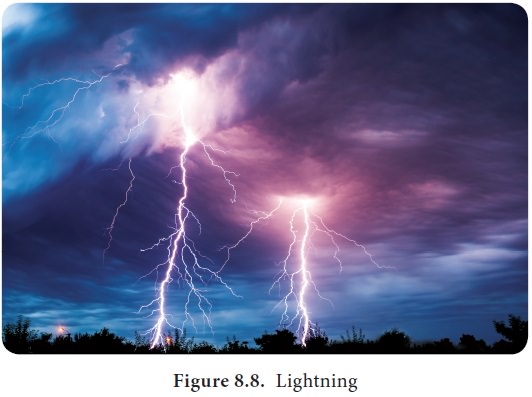Chapter: 11th Geography : Chapter 8 : Natural Disasters - Public Awareness For Disaster Risk Reduction
Lightning - Disaster and Rules of actions during disasters
Lightning
Lightning is an atmospheric
electrostatic discharge (spark) accompanied by thunder, which typically occurs
during thunderstorms, and sometimes during volcanic eruptions or dust storms.
Lightning generates 10-20 ampere current and it is therefore fatal. It is especially
dangerous for people in an open area.
Lightning strikes often have fatal
consequences. On an average, 2000 people die from lightning in the world every
year. Lightning mostly strikes tall things, such as trees that break down and
catch fire or it may strike power transmission lines and antennas fastened on
roofs and buildings which causing fire. The air temperature, when lightning
occurs, is as hot as 9982.2 °C.

Thunder is the sound caused by
lightning. A charged, superheated lightning bolt creates a “resonating tube” as
it travels. The air in the tube rapidly expands and contracts causing
vibrations that we hear as the rumble of thunder.
Lightning strikes can explode a tree.
Imagine 15 million volts of electricity hitting a tree branch. The heat travels
through the tree, vaporizing its sap and creating steam that causes the trunk
to explode.
Before lightning
•
If you are planning to go to the countryside, check the weather
forecast.
•
If a thunderstorm is expected it is better to postpone the trip.
•
It is good if you can estimate the distance to the front line of a
thunderstorm. In order to do this you must check the time interval from the
moment you see the lightning until you hear thunder. Lightning always precedes
thunder. We know that the sound speed travels on average about 1km every 3
seconds. Reduction of the time interval between the sight of lightning and the
resulting thunder means that the danger is approaching and protective measures
must be taken. If there is no interval between lightning and thunder means, it
means that the cloud is already over your head.
During Lightning:
• If you are in a building it is necessary to close windows, doors, ventilation pipes and chimneys.
•
It is necessary to turn off the telephone, TV set, and other electrical
equipment because lightning may strike electrical cables and pass through
wiring.
•
Do not take a shower because both water and metal conduct electricity.
•
Do not light the fireplace because the heat coming from the chimney may
attract lightning.
•
It is better to stay away from electric wires, lightning rods, water
pipes, antennas and windows.
•
If you are in an open area during a thunderstorm, do not stand under a
tall tree. Lighting is most damaging for tall trees. It is better to stay 30-40
meters away from them. Avoid trees that are standing separately. Remember that
lightning does not strike bushes.
•
If the area is open, it is better to find a lower place or a cavity and
squat there.
•
It is dangerous to stand or lie down on the ground, because this
increases the exposure area.
•
It is necessary to get rid of metal items such as a bicycle, coins etc.
•
Do not stand under an umbrella.
•
Do not run during the occurrence of lightning; move slowly towards a
shelter because the air flow may attract lightning;
•
If you are in a car, do not get out. It is better to close the windows
and turn of the antenna. Do not park your car under tall trees or any
structures that may fall down and hit you.
•
If there is an injured person next to you, remember that the victim may
lose consciousness. It is necessary to provide first aid.
•
Cover your mouth with a wet cloth in order to protect your lungs.
Related Topics